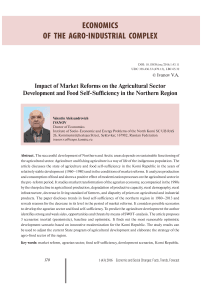Impact of market reforms on the agricultural sector development and food self-sufficiency in the northern region
Автор: Ivanov Valentin Aleksandrovich
Журнал: Economic and Social Changes: Facts, Trends, Forecast @volnc-esc-en
Рубрика: Economics of the agro-industrial complex
Статья в выпуске: 1 (43) т.9, 2016 года.
Бесплатный доступ
The successful development of Northern and Arctic areas depends on sustainable functioning of the agricultural sector. Agriculture and fishing agriculture is a way of life of the indigenous population. The article discusses the state of agriculture and food self-sufficiency in the Komi Republic in the years of relatively stable development (1960-1980) and in the conditions of market reforms. It analyzes production and consumption of food and shows a positive effect of modernization processes on the agricultural sector in the pre-reform period. It studies market transformation of the agrarian economy, accompanied in the 1990s by the sharp decline in agricultural production, degradation of productive capacity, rural demography, rural infrastructure, decrease in living standard of farmers, and disparity of prices on agricultural and industrial products. The paper discloses trends in food self-sufficiency of the northern region in 1980-2013 and reveals reasons for the decrease in its level in the period of market reforms...
Market reform, agrarian sector, food self-sufficiency, development scenarios, komi republic
Короткий адрес: https://sciup.org/147223799
IDR: 147223799 | УДК: 338.436.33 | DOI: 10.15838/esc/2016.1.43.11
Текст научной статьи Impact of market reforms on the agricultural sector development and food self-sufficiency in the northern region
The scientific literature adequately addresses the current crisis state of the agrarian sector and rural areas, threatening not only food, but also national security in general [1–7, 10–11]. The market transformation of the agrarian economy was accompanied by its de-industrialization; de-intellectualization of labor potential of the village: degradation of productive capacity, rural demography, industrial and social infrastructure of the village; impoverishment of peasants; deepening of differentiation in the development of the agricultural sector and the social sphere in the countryside among regions, agricultural producers, rural areas of the center and the periphery; sharp decline in agricultural production in the 1990s; de-ecologization of the agrarian sector, resulting in the destruction of the drainage, irrigation and chemical reclamation of land, excess of nutrient removal over its refund in the form of fertilizer; breaking of horizontal and vertical linkages in the agricultural sector; disparities in the inter-industry exchange of agriculture with other sectors of the economy. Overcoming the agrarian crisis, according to scientists and experts, requires a new model of the country’s agrarian policy and adequate mechanisms of its realization [3].
The purpose of this article is to study the consequences of market transformations affecting the agrarian economy and food selfsufficiency of the Komi Republic population.
Development of agriculture in 1960–1980
The analysis of agricultural production indicators dynamics in the Komi Republic for 30 years, conducted by means of regression equations, shows that the average annual growth rate of production per capita amounted to 1.5%, the unit of land area – 4.3, labor productivity in the public sector – 4.4%. Moreover, yields of crops, milk yield, and average daily weight gain of pigs were higher than in the Northern region as the whole.
The positive dynamics of crop and livestock production until the early 1990s (with the exception of potato production in 1975–1990) is revealed in Figure 1 .
The rates of increasing volumes of poultry and pork were the highest. In 1970–1990 with the overall 2.4-fold growth in meat production of all kinds, the production of poultry meat rose by 10.8 and pork – by 4.2 times. It is the result of the implementation of the industrial poultry and pig breeding development program.
The strategy for agrarian sphere development in the pre-reform period was determined by the intensification of agriculture through strengthening its material and technical base. In 1965–1990 the capitalarea ratio increased by 11.4 times, the capitallabor ratio – 9.4, electric power per worker – 12.4 times. The park of tractors rose by 2.7 times, harvesters – 4.2, potato harvesters – 25, and milking installations – 3. The level of mechanization of vegetables sowing and planting went up from 18 to 91%, grass mowing – from 30 to 100, potato harvesting – from 42 to 100%, including by means of – harvesters from 5% to 38%. In 1990 the level of comprehensive mechanization on cattle farms was 54%, at the complexes for production of – 75 milk and pork – 80%.
In the pre-reform period the agricultural sector introduced crop rotation, new varieties, breeds and crosses of poultry, advanced techno-
Figure 1. Dynamics of production of main kinds of products of crop and livestock production in all categories of farms in the Komi Republic in 1960–1990
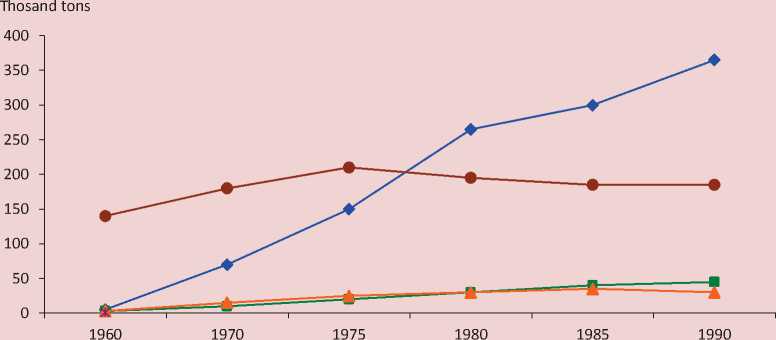
—•— Eggs, million items ■ Vegetables ▲ Meat (dead weight) • Potato
Compiled by: Agropromyshlennyi kompleks Respubliki Komi: istoriya i sovremennost’: stat. sb.[Agro-Industrial Complex of the Komi Republic: History and Modernity: Statistics Digest]. Komistat [Territorial Body of the Federal State Statistics Service in the Komi Republic]. Syktyvkar, 2011, pp. 59, 74.
logies. In the Republic the scientists and specialists of agriculture worked out and implemented the scientifically based system of agriculture, differentiated by natural areas [8, 9].
The measures were taken to improve land fertility. The system of soil fertility reproduction included the annual application of mineral and organic fertilizers, recurrent liming, technical works, and drainage melioration. The application of mineral fertilizers per 1 ha of sowing crops increased from 57 kg of active substance in 1965 to 135 kg in 1990 and the application of organic ones –from 12 to 18 tons, respectively.
The extensive work on personnel training and re-training was conducted. In 1990 one in five working in the industry had higher and secondary special education. Of specialists with higher education more than 70% were engineers, agronomists, zootechnicians and veterinarians. In the mid-1980s 2–3 thousand skilled workers were annually prepared for agriculture. Rural secondary school made a significant contribution to training young people. About 1,000 rural machine operators and about 700 milking machine operators left secondary schools every year.
There were positive changes in pricing through increased purchasing prices for agricultural products and the financial situation of agricultural enterprises. In 1990 the level of agricultural production profitability amounted to 44%, which corresponded to the optimal norm, making it possible to carry out the process of expanded reproduction on the basis of own funds. In addition, budget allocations were a significant funding source.
The aggregate income of rural households went up steadily; its level gradually approached urban indicators. In 1990 the total income for a rural family accounted for 85% of an urban one, and average per capita income of a villager – 73% of a citizen. There was a clear trend to increase provision of rural population with different types of social services; the comprehensive construction of central estates of households as strongholds of rural areas was conducted.
All this contributed to the improvement of food self-sufficiency of the population. In 1991 for local population meat consumption constituted 86% of science-based nutrition standards, milk and dairy products – 79, fish – 60, egg – 104, vegetables – 75, and sugar – 97%. The Republic residents’ consumption of food was close to the national average level, with consumption of meat and meat products, eggs, vegetables, vine crop, and sugar being even higher than in Russia.
However, agriculture had a lot of unresolved problems. Despite the increase in the capitalarea ratio, the capital-labor ratio and gross production, the negative tendencies in the agricultural sector development still remained: low crop yields, livestock productivity, labor productivity, and resource use efficiency, high loss of products, backlog of industrial and social infrastructure in rural areas, outflow of able-bodied population to cities, etc. Moreover, the 1970–1980s witnessed the decrease in output growth, labor productivity and the increase in the capital-output ratio and material capacity. Under these conditions, the increased production required greater amount of financial resources from the state. The situation in the agricultural sector formed in the late 1980s objectively demanded the creation of effective business entities, changes in ownership, and systemic reforms.
Still the processes taken place in agriculture in the pre-reform period can be considered as modernization both in terms of integrated rural development and specific production achievements.
Transformation of the agrarian sector in the period of market reforms
The analysis of market reforms does not allow us to give a clear assessment of current controversial socio-economic processes in the agricultural economy. In recent years the legal and organizational conditions for the operation of various forms of ownership and management are created and the foundations for market-based development mechanisms are laid. There is a new socio-economic structure of agricultural production, characterized by the presence of private, collective and individual legal forms of farming.
At the end of 2014 the Republic’s agricultural sector comprised of 148 organizations, including 111 large and medium, 37 small, 370 peasant (farm) households, 92 thousand private farms and 106 thousand families of gardeners. Among large and medium-sized agricultural enterprises the share of limited liability companies was 69%, production agricultural cooperatives – 27, municipal enterprises – 3, and open joint-stock companies – 1%.
In the total gross agricultural production in 2014 the share of agricultural enterprises accounted for 57.3%, households of the population – 38.1, peasant (farm) house- holds – 4.6%. Agricultural companies dominate the production of eggs, meat and milk, and households of the population – the production of potatoes and vegetables: farm households do not play a significant role in the production of agricultural products (they increased the share of milk production from 2.4% in 2005 to 12.1% in 2014). Since the mid-2000s the role of collective farms in production of agricultural products has been growing. In the structure of gross output the share of agricultural enterprises rose from 46% in 2005 to 57% in 2014, farm households – from 1.7 to
4.6, the share of households of the population declined from 53% to 38% ( tab. 1 ).
The transition to the market economy with the help of monetarist approaches had a very negative impact on the agricultural sector. In 1990–2014 production of cattle meat decreased by 5.3 times, pork – 3.6, milk – 3.2, and eggs – 2.9. There was only the 43% growth of poultry meat production. This result was provided by the development of meat production in OJSC “Zelenetskaya Poultry Farm”. Particularly severe decline in crop production was observed in collective farms ( fig. 2 ).
Table 1. Dynamics of the ratio of the share of different social types of households in the agricultural production in the Komi Republic, %
|
Indicator |
1990 |
1995 |
2000 |
2005 |
2010 |
2014 |
|
Potato agricultural companies |
42.1 |
14.4 |
12.0 |
9.6 |
4.0 |
5.3 |
|
households of the population |
57.9 |
84.7 |
87.0 |
89.0 |
94.6 |
92.4 |
|
farm households |
0.0 |
0.9 |
1.0 |
1.4 |
1.4 |
2.3 |
|
Vegetables agricultural companies |
89.6 |
50.7 |
35.3 |
22.4 |
22.5 |
18.3 |
|
households of the population |
10.4 |
49.2 |
63.8 |
75.3 |
77.0 |
78.6 |
|
farm households |
- |
0.1 |
0.9 |
2.3 |
1.5 |
3.1 |
|
Meat (in slaughter weight) agricultural companies |
79.9 |
57.4 |
54.2 |
69.7 |
81.6 |
87.8 |
|
households of the population |
20.1 |
41.7 |
44.8 |
28.0 |
16.2 |
9.7 |
|
farm households |
- |
0.9 |
1.0 |
2.3 |
2.2 |
2.5 |
|
Milk agricultural companies |
84.6 |
63.6 |
50.0 |
45.6 |
53.4 |
62.8 |
|
households of the population |
15.4 |
35.3 |
48.8 |
52.0 |
39.8 |
25.1 |
|
farm households |
- |
1.1 |
1.2 |
2.4 |
6.8 |
12.1 |
|
Egg agricultural companies |
97.7 |
95.4 |
98.7 |
99.2 |
98.7 |
96.9 |
|
households of the population |
2.3 |
4.5 |
1.3 |
0.8 |
1.2 |
2.1 |
|
farm households |
- |
0.1 |
0.0 |
0.0 |
0.1 |
1.0 |
|
Gross production agricultural companies |
80.1 |
53.0 |
48.5 |
45.6 |
53.8 |
57.3 |
|
households of the population |
19.9 |
46.1 |
50.7 |
52.7 |
42.4 |
38.1 |
|
farm households |
- |
0.9 |
0.8 |
1.7 |
3.8 |
4.6 |
Calculated by: 1. Sel’skoe khozyaistvo v Respublike Komi. 2009: stat. sb. [Agriculture in the Komi Republic. 2009: Statistics Digest]. Komistat [Territorial Body of the Federal State Statistics Service in the Komi Republic]. Syktyvkar, 2009, pp. 27, 63, 106. 2. Sel’skoe khozyaistvo v Respublike Komi. 2014: stat. sb. [Agriculture in the Komi Republic. 2014: Statistics Digest]. Komistat [Territorial Body of the Federal State Statistics Service in the Komi Republic]. Syktyvkar, 2015, pp. 6, 49, 73.
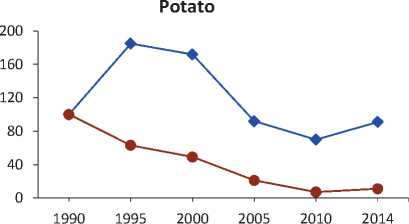
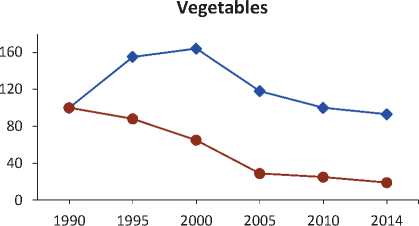
Beef
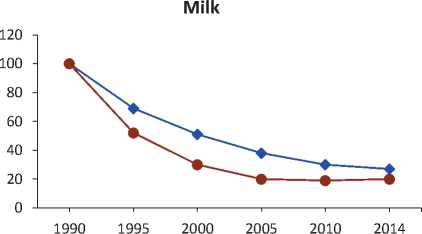
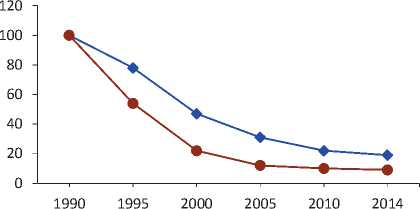
Poultry
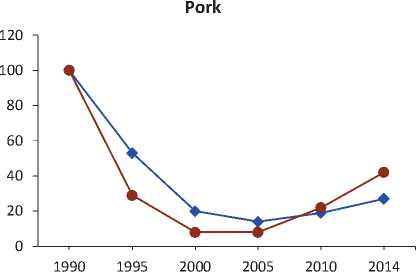
Reindeer meat
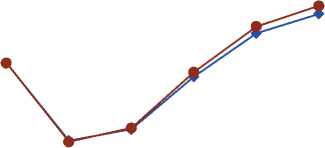
1990 1995 2000 2005 2010 2014
1990 1995 2000 2005 2010 2014
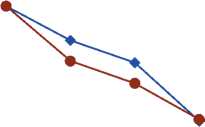

Egg
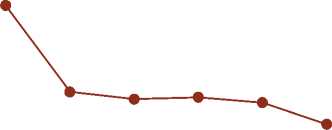
1990 1995 2000 2005 2010 2014
Figure 2. Dynamics of production of agricultural products in the Komi Republic in 1990–2014 (1990=100)
Compiled by: Sel’skoe khozyaistvo v Respublike Komi: stat. sb. [Agriculture in the Komi Republic: Statistics Digest]. Komistat [Territorial Body of the Federal State Statistics Service in the Komi Republic].
The agricultural sectors of the Arctic (the urban district of Vorkuta) were seriously affected. During the period under review the production of milk went down by 174 times. In 1990 the city had 7 farms and more than 20 households. There were 9.5 thousand heads of cattle, including 4.8 thousand cows, and more than 7 thousand pigs. In 2015 there was only one agricultural enterprise. The number of cows was reduced to 4, pigs – 123.
In the period of market reforms the steady decline in production of beef and veal was recorded. Due to the structural shifts the share of cattle meat decreased from 52% in 1970 to 37% in 1990 and 16% in 2014, while the share of poultry meat increased from 5 to 24 and 63%, respectively.
The decline in crop and livestock production is caused by the reduced acreage and number of animals, especially in agricultural enterprises, where in 1990–2014 the acreage of crops went down by 3.1 times, potato – 15, vegetables – 19, and forage crops –2.9 times. The growth of population’s cultivated areas was observed until 2000. The stock of cattle in agricultural enterprises decreased by 7.9 times, cow – 6.9, pigs – 4.3, and poultry – 2.3 times. At the same time, milk production per cow increased by 20%, hen-day average – 13, average daily gain of pigs – 87%, but average daily gain of cattle decreased by 12%.
There was a decrease in cattle and egg poultry production per capita. During the study period with the 1.4 decrease in population, milk production per capita decreased from 166 to 65 kg, beef – from 11.2 to 2.3 kg, eggs – from 294 to 144 items.
Production of poultry meat for this period increased from 7.4 to 15.2 kg.
The decline in animal breeding affected the processing industry adversely. In 1990– 2014 the production of dairy products in recalculation on milk decreased by 5.9 times and oil – by 3.5 times. As for meat and meat products, the maximum decline in their production was observed until 2000, and then due to the increased production of poultry meat there was stabilization and growth of production of meat products. In 2014, compared to 2000, there was a 2.9-fold rise in meat production.
The reform years witnessed degradation of productive capacity due to the sharp reduction in investment. Investment in fixed capital of agriculture in total investment declined from 5.7 to 0.4% in 1990–2014, with the share of agriculture in gross regional product being equal to 1.3%. The rate of decline in investment in the agricultural sector is by more than four times higher than in the whole country. Fixed assets in the industry are worn nearly by half, and in most rural areas – by 70–80%.
The park of tractors in this period decreased by 9 times, machines for sowing – 11, balers – 5, forage harvesters – 4, potato harvesters –12, machines for making solid organic fertilizers – 29, machines for making liquid organic fertilizers – 13, milking installations – 10, and the amount of generating capacity – 6. The technology update stopped until the implementation of the priority national project “AIC Development” ( tab. 2 ).
Table 2. Coefficients of the update of key types of machinery in the agricultural organizations of the Komi Republic
|
Types of equipment |
1990 |
1995 |
2000 |
2005 |
2008 |
2009 |
2010 |
2014 |
|
Renewal coefficient |
||||||||
|
Tractors of all brands |
10.0 |
2.0 |
5.0 |
1.6 |
3.1 |
6.3 |
2.8 |
4.4 |
|
Forage harvesters |
16.1 |
4.4 |
4.1 |
4.8 |
9.1 |
11.8 |
5.8 |
20.7 |
|
Potato harvesters |
19.6 |
0.5 |
2.2 |
- |
- |
31.3 |
- |
- |
|
Milking machines |
14.3 |
2.0 |
1.7 |
2.0 |
- |
3.1 |
1.1 |
13.9 |
|
Retirement rate |
||||||||
|
Tractors of all brands |
9.4 |
11.3 |
10.0 |
7.6 |
8.5 |
3.2 |
4.4 |
5.5 |
|
Forage harvesters |
7.5 |
36.7 |
5.3 |
25.0 |
- |
6.8 |
3.9 |
- |
|
Potato harvesters |
17.1 |
10.8 |
17.8 |
6.6 |
- |
9.1 |
- |
12.5 |
|
Milking machines |
9.7 |
19.1 |
8.9 |
21.5 |
2.9 |
2.0 |
4.2 |
6.3 |
|
Calculated by: Sel’skoe khozyaistvo v Respublike Komi: stat. sb. [Agriculture in the Komi Republic: Statistics Digest]. Komistat [Territorial Body of the Federal State Statistics Service in the Komi Republic]. |
||||||||
Technical equipment of livestock deteriorated significantly. The number of milking machines decreased by 9.8 times in 1990– 2014. The indicators of commissioning of individual capacities reduced dramatically due to new construction, expansion and reconstruction. If 2.8 thousand cattle stalls were commissioned in 1990, in 2014 – 0.5 thousand units; the work on drainage land reclamation was terminated in 2007.
In crop production agrochemical and water-physical properties of soil are aggravated and the area of marshy and bushy land expanded due to the destruction of drainage systems and almost the cessation of reclamation work. The application of mineral fertilizers in recalculation on 100% of nutrients per 1 ha of sowing fell from 135 in 1990 to 20 kg in 2014, organic – from 18 to 4.2 tons. If in 2014 crop plants were nourished by mineral fertilizers by 23% and organic ones by 10%, in 1990 the figures were 81% and 26%, respectively. The area of meadows and pastures fertilized with mineral fertilizers reduced especially sharply. At the same time, the area under crops fertilized with mineral fertilizers in agricultural companies decreased by more than 8 times, the fertilized area of natural forage lands – by 25 times. As a result, the removal of nutrients from the soil exceeds their introduction.
During the years of market reforms the number of people employed in agriculture went down by 6 times (from 29.5 thousand people in 1990 to 4.4 thousand people in 2014). The outflow of workers from agriculture led to a shortage of qualified personnel in the industry. In the Republic in the total number of employees in agriculture having vocational education the share of specialists with higher education accounts for 10%, with average – 21%. In the rural periphery these figures are lower: 7 and 15%, respectively. The low level of professional education is observed on peasant
(farm) households. Here the share of workers with higher education accounts for 5%, with average – 10%. In the Republic the system of agricultural professional education almost collapsed (Komi Branch of the Vyatka State Agricultural Academy is closed, agricultural specialties in Syktyvkar Forest Institute and secondary specialized educational institutions are shortened and re-profiled).
Market transformation deepened the differentiation in incomes of employees of agriculture and other industries. Average nominal wages of the employed in the agrarian sector are by 2 times lower than in the whole national economy. In all rural areas, except for Syktyvdinsky District and Priluzsky District, wages are well below subsistence minimum of the able-bodied population. Low incomes, poor housing, poor infrastructure, and high unemployment have a negative effect on migration processes of the village, especially remote rural areas.
The countryside lags much behind the city by the development of social infrastructure and quality services. Individual housing in rural areas has virtually no amenities. Most peripheral municipalities do not have paved roads to the city of Syktyvkar.
The realization of the priority national project “Development of AIC” since 2006 results in a number of positive trends in the agrofood sector of the Republic. The volume of investment into fixed capital of agriculture in comparable prices for 2006–2014 doubled, the food industry – by 2.6 times. This leads to the upgrade of machinery and equipment (see tab. 2). In 2010–2014 the implementation of 13 investment projects involved commissioning of 1.9 thousand stalls for cattle and 1.23 thousand stalls for pigs and reconstruction of 3.8 thousand stalls. In 2016 LLC “Prigorodnyi” completed construction of the complex for storage and preselling preparation of potatoes and vegetables of open ground with a capacity of 3200 tons.
Modernization processes in meat poultry farming and pig breeding contributed to the increased production of broiler meat and pork. Since 2007 there has been steady growth in the production and sale of products of the fishing industry.
The share of profitable agricultural enterprises increased from 33% in 2006 to 72% in 2014; average monthly nominal accrued wages of workers employed in agriculture in the region rose by 3.2 times (from 6.5 to 20.8 thousand rubles).
The implementation of measures to upgrade production ensured the creation of 454 jobs in the agricultural sector over the past four years, including 135 job places in 2014, of them – 56 new jobs.
The Republic continues to carry out measures to improve living conditions in rural areas. A number of projects on gas, water and amenities provision are implemented in rural settlements. In 2010–2014 the housing conditions of 326 rural citizens with the provision of social benefits are improved, including 153 young families and professionals. 34.8 thousand square meters of housing was commissioned.
However, the current socio-economic state of the agricultural sector, primarily in peripheral (remote) rural areas, is characterized as unstable and can become extremely negative due to the eliminated agricultural production and the reduced inhabited rural area.
Impact of market reforms on food selfsufficiency
The modernization processes in the prereform period contributed to the increase in agricultural production and food selfsufficiency. The dynamics of changes in the level of self-sufficiency of the Komi Republic population in food in the reform period indicates the decline in the rate of food selfsufficiency in animal products. In 1990–2013
the level of population’ self-sufficiency in meat and meat products fell from 39 to 28%, milk and dairy products – from 40 to 23%, egg from 94 to 48%, potatoes rose from 68 to 102%, and vegetables – from 16 to 26% ( fig. 3 ).
The decline in production of livestock products, together with the reduction in purchasing capacity of the population, determined the decrease in its consumption by the population in the 1990s. Increased import of food, raised production of poultry meat, and grown income of the population since the mid of the 2000s had a positive impact on the consumption of animal products, fish, vegetables and vine crops, vegetable oils, fruits and berries ( tab. 3 ).
Figure 3. Self-sufficiency of the Komi Republic population in basic food, %
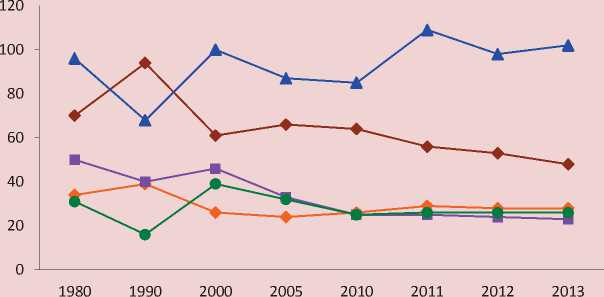
— ♦ — Meat and meat products
— ■ — Milkanddairyproducts
— ♦ — Eggsandeggproducts
—*— Potato
—•— Vegetables
Based on: 1 Agropromyshlennyi kompleks Respubliki Komi: istoriya i sovremennost’: stat. sb.[Agro-Industrial Complex of the Komi Republic: History and Modernity: Statistics Digest]. Komistat [Territorial Body of the Federal State Statistics Service in the Komi Republic]. Syktyvkar, 2011, pp. 86-87. 2. Sel’skoe khozyaistvo v Respublike Komi. 2014: stat. sb. [Agriculture in the Komi Republic. 2014: Statistics Digest]. Komistat [Territorial Body of the Federal State Statistics Service in the Komi Republic]. Syktyvkar, 2015, p. 103.
Table 3. Per capita consumption of basic food in the Komi Republic, kg
|
Food |
Rational consumption rate* |
1965 |
1970 |
1980 |
1990 |
2000 |
2010 |
2013 |
|
Meat and meat products |
70–75 |
40 |
52 |
69 |
70 |
51 |
76 |
80 |
|
Milk and dairy products |
320–340 |
258 |
295 |
341 |
396 |
211 |
264 |
271 |
|
Egg and egg products, items |
260 |
90 |
136 |
306 |
290 |
259 |
273 |
267 |
|
Fish and fishery products |
18–22 |
25 |
18 |
15 |
21 |
|||
|
Sugar |
24–28 |
47 |
56 |
43 |
39 |
38 |
||
|
Vegetable oil |
10–12 |
7.7 |
9.1 |
12.8 |
13.8 |
13.6 |
||
|
Potatoes |
95–100 |
133 |
124 |
131 |
95 |
113 |
56 |
55 |
|
Vegetables and vine crops |
120–140 |
59 |
68 |
81 |
90 |
81 |
91 |
96 |
|
Fruits and berries |
90–100 |
29 |
50 |
58 |
||||
|
Bread products |
95–100 |
128 |
127 |
125 |
116 |
109 |
116 |
111 |
|
Compiled by: 1. Agropromyshlennyi kompleks Respubliki Komi: istoriya i sovremennost’: stat. sb.[Agro-Industrial Complex of the Komi Republic: History and Modernity: Statistics Digest]. Komistat [Territorial Body of the Federal State Statistics Service in the Komi Republic]. Syktyvkar, 2011, p. 88. 2. Sel’skoe khozyaistvo v Respublike Komi. 2014: stat. sb. [Agriculture in the Komi Republic. 2014: Statistics Digest]. Komistat [Territorial Body of the Federal State Statistics Service in the Komi Republic]. Syktyvkar, 2015, p. 103. * Recommended rational consumption norms, approved by the Ministry of Healthcare and Social Development of the Russian Federation of August 2, 2010 No. 593n. |
||||||||
In the Komi Republic nowadays per capita consumption of meat and meat products exceeds the rational norm by 5–10 kg, eggs – 6 items, fish – 1–5 kg, cereals – 6–16, sugar – 10–14, and vegetable oil – 1.6–3.6 kg. It should be noted that the rational norms of consumption in the Far North compared to temperate climates recommended by the Scientific Research Institute of Nutrition of the Russian Academy of Medical Sciences should be higher: meat – by 1.2–1.25 times, milk – 1.23–1.3, fish – 1.4–1.5, and vegetables – 1.35–1.4 times. Therefore, taking into account the northern specifics, the level of food consumption based on the scientifically valid standards is significantly lower in the Republic.
Scenarios of possible development of the agricultural sector and food self-sufficiency
When substantiating prospects for food self-sufficiency in the Komi Republic we should identify strengths and weaknesses of the agricultural sector, opportunities and threats to its development by means of the SWOT analysis ( tab. 4 ).
In connection with the difficult natural and economic conditions for agriculture development in the Komi Republic and other regions of the Russian North, the principle of food self-sufficiency is unacceptable. According to A.N. Chekavinskii, in 2014 the self-sufficiency of the European North in meat was 41%, milk– 45, and egg – 65% [11, p. 142]. However, production of basic food under favorable conditions is the objective necessity in the North in the foreseeable future. The priority directions to develop agrarian and trade economy in the Komi Republic: production of socially significant food products – potatoes, vegetables of local assortment, whole milk, fresh meat, eggs; preservation and development of traditional industries, and collection of wild fungi and berries and their processing.
Table 4. SWOT-analysis to forecast the development of agriculture and food self-sufficiency in the Komi Republic
|
Strengths |
Weaknesses |
|
Competitiveness of traditional northern industries at the national and international markets. High demand and guaranteed consumption of local products. Significant natural and labor resources. Long daylight hours during the growing season, good supply of plants with moisture. High genetic potential of cattle. Favorable conditions for production and export of organic products Significant potential of agricultural science. |
Adverse natural conditions for agriculture. Low provision with farm resources. Heavy dependence of livestock production on the supply and market conditions of concentrated feed. Outdated technology and equipment. Deficit, low professional qualification of the staff. Low level of innovation activity of agricultural organizations. Insufficient level of management. Inefficient mechanisms of territorial distribution of financial support. Lack of a clear development strategy. Limited access of agricultural producers to food markets, logistical means and financial resources. Low quality of rural living environment (poor infrastructure, landscaping, services) Low of life quality of peasants. Unstable sales of agricultural products, removal of local producers from food markets. Low productivity, crop yield, livestock productivity. Insufficient competitiveness of agricultural and food products. |
|
Opportunities |
Threats (risks) |
|
Increased production of local products. Transition to the international standards of quality and safety of products. Creation of integrated structures in the system of production, processing and sales. Availability of budget funds for modernization and integrated rural development. Participation of industrial enterprises in the financing of agricultural and rural development. Activation of state and municipal policies to promote the agrifood sector. |
Physical and moral obsolescence of the material and technical base. Dependence of food production on imported technologies. Reduction of biological resources. Outflow of qualified personnel. Decrease in the rural population, its ageing will be a barrier to the development of agrarian economy in the future. Decline of profitability and investment attractiveness, agricultural bankruptcy of economic entities in the conditions of Russia’s membership in WTO. Unfavorable external conditions (sanctions, economic crisis, price disparity). Decline in financial support, unavailability of soft loans. Increase in the differentiation in agricultural and rural development. Deterioration of the socio-economic situation in the village in connection with the collapse of agricultural production. |
Table 5. Options of the forecast of development of the agricultural sector and food-sufficiency in the Komi Republic in 2016–2030
|
Scenarios of development |
Expected socio-economic results |
|
Inertial (pessimistic) |
Reduction in the number of farm and private households. Increase in pig breeding and fisheries in the near future. Stabilization or slight growth of production of milk, beef, poultry and reindeer. Outflow of qualified personnel from the industry. Low profitability of agricultural activities. Increase in the lifeless space in peripheral areas. The level of self-sufficiency in potatoes will be 85-90%, vegetables – 18-23, meat and meat products – 23-28, milk and dairy products – 19-24, eggs – 48-53%. |
|
Basic |
Slight modernization of the agrarian economy and rural infrastructure. Small increase in investment and innovation activity. Creation of the conditions to reduce the provision of the industry with personnel. Development of cooperation and integration processes. Moderate rate of agricultural production growth. The level of self-sufficiency in potatoes will be 90-95%, vegetables – 23-28, meat and meat products – 25-30, milk and dairy products – 24-29, eggs – 60-65%. |
|
Optimistic |
Mixed agrarian economy will be formed. Active innovative modernization of the agrofood sector and rural infrastructure. Production of organic products will develop rapidly. Deep processing of products of cattle breeding, reindeer herding and wild plants, expanding the range of food products with new consumer properties. The average annual growth rate of agricultural production will be 4-5%. Full self-sufficiency of the population in potato and vegetables of the local range (except for early production). The level of self-sufficiency in vegetables will make up 45-50%, meat and meat products – 35-40, milk and dairy products – 40-45, eggs – 75-80%. |
To forecast the development of agriculture and food self-sufficiency in the Komi Republic for the next 15 years there are 3 scenarios: inertial (pessimistic), basic and optimistic ( tab. 5 ). In all forecast options it is necessary to consider the ongoing systemic crisis of the agricultural sector.
The inertial (pessimistic) scenario does not assume the significant growth of agrarian economy. The deterioration of the socioeconomic situation depending on the influence of adverse external conditions (accession to the WTO, sanctions, economic crisis, high inflation), the conservation of price disparity on agricultural and industrial products, the reduction in financial support and availability of preferential credit resources and the strengthening of the outflow of skilled personnel from the village are possible. In the village the worsening of the demographic situation will continue and, as a consequence, the habitable rural area will reduce.
The basic scenario assumes continuation of the current rates of change in the performance of agriculture, the level of state support of the industry, the conditions of inter-sectoral exchange in the agricultural sector, the access of organizations and households to financial markets, the price and tax policy, and the relatively low investment in production capacity upgrade. According to this scenario, the growth in agricultural production will occur in the suburban and its reduction in the peripheral areas. The level of self-sufficiency in food will increase only slightly.
The optimistic scenario is characterized by the use of selective-genetics, technical-technological, organizational-economic and socio-ecological innovations that form the fifth and sixth technological structures in the agro-food sector; the active protectionist policy of the state, the use of effective tools and mechanisms of strategic development: increase in investment aimed at improving soil fertility, upgrade of productive capacity; attraction of qualified personnel into the industry; the improvement of the placement, specialization, cooperation and integration in the agrifood sector, providing a closed cycle of agricultural production, its processing and marketing; the development of industrial infrastructure, the significant enhancement of social and living conditions, quality and standard of life of peasants.
The research in the state of the agricultural sector and food self-sufficiency in the prereform and market periods allows us to draw the following conclusions and recommendations.
-
1. The 30-year period prior to the market reforms is most favorable for agricultural sector development and local food provision. The 1960–1980s agricultural policy aimed at accelerating the pace of intensification and industrialization of agricultural production
ensured the stable growth of production and labor productivity, the improvement of the level and quality of life of peasants. In the early 1990s the Republic produced the statutory minimum amount of food necessary for sustainable livelihood.
-
2. The 1990s agrarian reform, representing a long process, was conducted rashly on the basis of revolutionary, not evolutionary methods and by some provisions it was obviously wrong. In practice, the main directions of agrarian reform were not to improve the efficiency of agricultural production through modernization, but through conversion of land ownership, reorganization of state and collective farms and their fragmentation; liberalization of prices for material and technical resources purchased by agricultural producers and deterrence of prices for agricultural products that created unequal economic conditions of inter-branch exchange of activity results; minimization of agrarian sector subsidizing; focus on food import.
-
3. The market transformation was accompanied by the destruction of the material-technical base of agriculture, the sharp reduction in the cultivated land and the number of animals and workers, the deterioration of people’s professional level and quality of life, the decline of agricultural production, especially on collective farms. During the reform years the crop and livestock production fell to the volumes of the second half of the 1950s. The north village is undergoing a systemic crisis. The decline in animal production involved the reduced rate
of food self-sufficiency. Now the share of imported food of animal origin to the amount of own production is substantially higher than in 1990.
-
4. The future of agriculture and food selfsufficiency is represented in the scenarios: inertial (pessimistic), basic and optimistic. The most acceptable scenario for agriculture development is optimistic, based on the mixed agrarian economy and its innovative type of reproduction. For its implementation it is first necessary to overcome the negative effects of sharp industry’s transition to the market economy using monetarist approaches and create the multipurpose agricultural policy focused on the agrofood sector upgrade. The possibility of implementing the optimistic scenario will depend on the coordinated work of the Ministry of Agriculture and Food, Ministry of Economic Development and other departments of the Komi Republic aimed at attracting greater investment in the
-
5. The realization of the optimistic variant of agrarian sector development will fully provide the population with potatoes and vegetables of open ground of local range (except early production), expand production of vegetables in greenhouses, raise selfsufficiency in meat and meat products up to 30–40%, milk and dairy products – 40–45, egg – 75–80%. The achievement of marked results will contribute to the improvement of living conditions in the harsh climate.
-
6. The key results of the study can be used as a basis for the development and adoption of managerial decisions by the regional agricultural authorities and municipalities when working out the state program for agro-food sector development and boosting agriculture in the Komi Republic.
agricultural sector, research and educational programs and infrastructure projects in remote rural areas and bettering the level and quality of life of peasants.
Список литературы Impact of market reforms on the agricultural sector development and food self-sufficiency in the northern region
- Agrarnaya politika sovremennoi Rossii: nauchno-metodologicheskie aspekty i strategiya realizatsii . Moscow: VIAPI imeni A.A. Nikonova: “Entsiklopediya rossiiskikh dereven'”, 2015. 518 p.
- Buzdalov I.N. Rossiiskoe selo i krest'yanstvo v tiskakh monopol'nogo okruzheniya . Moscow: GNU VSTISP Rossel'khozakademii, 2013. 225 p.
- Buzdalov I.N. Agrarnaya politika: nauchnye osnovy i “osobyi put'” ee osushchestvleniya v Rossii . Agrarnaya politika sovremennoi Rossii: nauchno-metodologicheskie aspekty i strategiya realizatsii . Moscow: VIAPI im. A.A. Nikonova: “Entsiklopediya rossiiskikh dereven'”, 2015, pp. 46-53.
- Ivanov V.A. Agrarnyi sektor Severa Rossii: transformatsionnye protsessy, perspektivy i mekhanizmy ustoichivogo razvitiya . Syktyvkar: Komi NTs UrO RAN, 2012. 168 p.
- Костяев А.И., Никонова Г.Н. ПОЛИТИКА «РЫНОЧНОГО ФУНДАМЕНТАЛИЗМА»: ПОСЛЕДСТВИЯ ДЛЯ АПК И ПУТИ ИХ ПРЕОДОЛЕНИЯ // Никоновские чтения. 2015. № 20-1 (20). С. 7-10.
- Ivanov V.A., Mikusheva T.Yu., Terent'ev V.V. Osobennosti i mekhanizmy agrarnogo sektora periferiinykh sel'skikh raionov severnogo regiona . Syktyvkar: GOU VO KRAGSiU, 2014. 204 p.
- Pshikhachev S.M. Agrarnaya politika i tip razvitiya: imperativnost' vzaimosvyazi i vzaimodeistviya . Agrarnaya politika sovremennoi Rossii: nauchno-metodologicheskie aspekty i strategiya realizatsii . Moscow: VIAPI im. A.A. Nikonova: “Entsiklopediya rossiiskikh dereven'”, 2015, pp. 24-28.
- Zaboeva I.V., Kanev G.V., Terent'ev V.V. Sistema vedeniya sel'skogo khozyaistva Komi ASSR. Organizatsionno-ekonomicheskie osnovy vedeniya sel'skogo khozyaistva agropromyshlennogo kompleksa . Syktyvkar: Komi kn. izd-vo, 1985. 116 p.
- Zaboeva I.V., Kanev G.V., Terent'ev V.V. Sistema vedeniya sel'skogo khozyaistva APK Komi SSR na 1991-1995 gody . Syktyvkar: Komi kn. izd-vo, 1991. 208 p.
- Terent'ev V.V. Kadrovoe obespechenie modernizatsii sel'skogo khozyaistva severnykh i arkticheskikh territorii (na primere Respubliki Komi) . Ekonomicheskie i sotsial'nye peremeny: fakty, tendentsii, prognoz , 2013, no. 4 (28), pp. 151-165.
- Uskova T.V., Selimenkov R.Yu., Anishchenko A.N., Chekavinskii A.N. Prodovol'stvennaya bezopasnost' regiona . Vologda: ISERT RAN, 2014. 102 p.
- Chekavinskii, A.N. Rezervy rosta molochnogo skotovodstva v Vologodskoi oblasti v kontekste resheniya strategicheskikh zadach gosudarstva po osvoeniyu Arktiki . Ekonomicheskie i sotsial'nye peremeny: fakty, tendentsii, prognoz , 2015, no. 4 (40), pp. 139-150.

